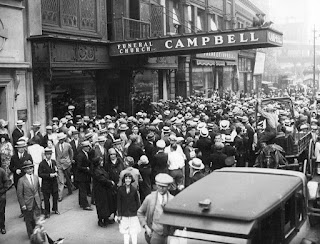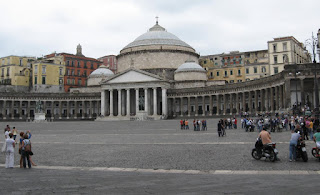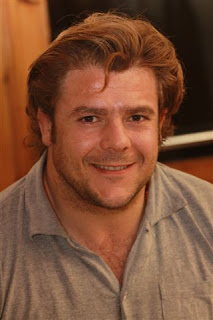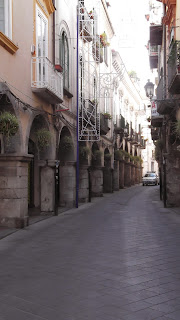Heart-throb actor who died tragically young
 |
Rudolph Valentino in a publicity shot for his
hit movie The Four Horsemen of the Apocalypse |
The man who would become Rudolph Valentino was born on this day in 1895 in Castellaneta, a small town in a rocky region of Puglia notable for steep ravines.
Born the second youngest of four children by the French wife of an Italian veterinary surgeon, he was christened Rodolfo Alfonso Raffaello Pierre Filibert Guglielmi di Valentina d'Antonguolla.
When he arrived in America as an immigrant in 1913, he was registered as
Rodolfo Guglielmi. His first movie credit listed him as Rudolpho di Valentina and he appeared under nine different variations of that name before achieving fame as Rudolph Valentino in
The Four Horsemen of the Apocalypse in 1920.
During the silent movie boom, he enjoyed more success in
The Sheik, Blood and Sand, The Eagle and
The Son of the Sheik and his smouldering good looks made him a 1920s sex symbol, nicknamed "The Latin Lover" and adored by countless female fans.
Yet his route to fame was difficult. Unable to find work at home, he joined the exodus of southern Italians to the United States and aged just 18 boarded a boat to
New York, disembarking at Ellis Island on 13 December, 1913.
He soon ran out of money and, even in the harsh New York winter, he had to sleep rough in Central Park. Eventually, after working as a dishwasher and a gardener, he found employment at
Maxim's Restaurant-Cabaret as a "taxi dancer", a paid-for partner for female clients.
Maxim's attracted a wealthy clientele and it is there that Valentino began to capitalise on his good looks and natural charm to become a sought-after partner. But he had to leave after the relationship he developed with a Chilean heiress landed him in jail.
When the lady in question sought a divorce from her husband, Valentino agreed to take the stand to support her claims of infidelity on her husband's part, testifying that he was seeing a female dancer at Maxim's. Out of revenge, the husband, a well-connected businessman, had Valentino arrested, along with a known madam, on trumped-up vice charges.
He was released after only a few days but the scandal cost him his job and when the heiress then shot her ex-husband during a custody dispute, he decided it would be in his interests to move on and he joined a travelling musical troupe that would eventually lead him to the West Coast, and Hollywood.
There he inveigled himself with more wealthy women by offering private dance tuition. At the same time, he was pursuing his ambition to work in the cinema and landed a series of bit-part roles.
It was while travelling to Florida for one of these that he read the novel
The Four Horsemen of the Apocalypse, by the Spanish author Vicente Blasco Ibáñez, and decided to seek out June Mathis, a screenwriter for Metro Pictures, who had bought the rights to the novel, in the hope of securing a part. As it happens, Mathis had seen him perform and already had him in mind.
The movie was a massive success, one of the first to make more than $1 million at the box office, and Valentino became a star. He was paid accordingly. At his peak he earned $10,000 a week at a time when the average wage in the United States was $2,000 a year.
Yet contentment eluded him. At times difficult to work with, he clashed with a number of directors and a bitter dispute with one of his studios led to him being unable to work at all after they refused to release him from his contract. Despite his earnings power, he also ran up huge debts.
Although he was married twice, albeit divorced both times, he found himself the target for gossip and innuendo about his sexuality. His taste for jewellery and exotic clothes led some male writers to imply that he was gay. One columnist enraged him so much he took boxing lessons from
Jack Dempsey, the world heavyweight champion, and challenged the writer to a fight.
 |
Crowds gather outside the Campbell Funeral Home in
New York ahead of Rudolph Valentino's funeral |
Valentino's death in 1926 at the age of only 31 shocked the world. He collapsed at a New York hotel and was taken to hospital. At first he was thought to have appendicitis but it transpired he had perforated gastric ulcers. This in turn led him to develop peritonitis and pleuritis, conditions affecting the membranes lining his abdomen and lungs, which proved fatal.
The outpouring of grief among his fans was such that 100,000 people, mainly female, lined the streets of New York as his funeral cortege made its way to
St Malachy's Roman Catholic Church in the Broadway theatre district. A similar number were said to have filed past his coffin at the Frank Campbell Funeral Home, where his body was displayed for a number of days before the private ceremony.
Although his debts meant there was little in his estate to pay the costs, a second funeral then took place in Beverley Hills in California and Valentino's body was laid to rest in the Hollywood Memorial Park Cemetery, in a crypt provided by June Mathis, his scriptwriter friend, who had bought it for a husband she subsequently divorced.
Travel tip:
Valentino is honoured in several ways in his home town of
Castellaneta. A Rudolph Valentino Museum was opened in his childhood home and a statue unveiled in 1961. A Foundation was created to promote his life and his work and in 2009 a film school - the
Centro Studi Cine Club Rodolfo Valentino Castellaneta - was opened in the town.
 |
| Rudolph Valentino's family home in Castellaneta |
Travel tip:
The
Valentino Museum, where the exhibits include the bed in which he slept as a boy, can be found on Via Vittorio Emanuele, in the old part of Castellaneta, which has a medieval layout of narrow alleys and streets and sits on a ridge above the sheer-sided Gravina di Castellaneta.
(Photo of Valentino family home by Pietro d'Ambrosio CC BY-SA 3.0)
More reading
Pina Menichelli: silent movie diva who achieved worldwide fame
How Shakespeare made Zeffirelli a household name
Spaghetti westerns opened doors for top producer
Also on this day:
1527: The Sack of Rome
1963: The birth of Alessandra Ferri, prima ballerina assoluta
Home

















